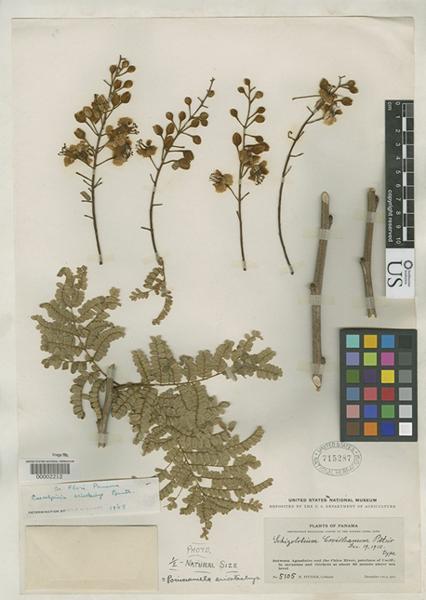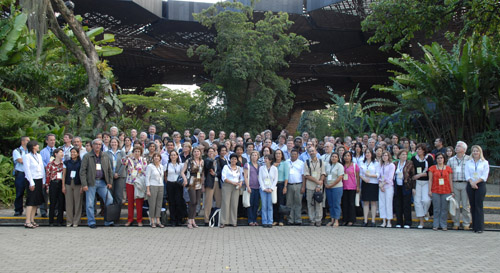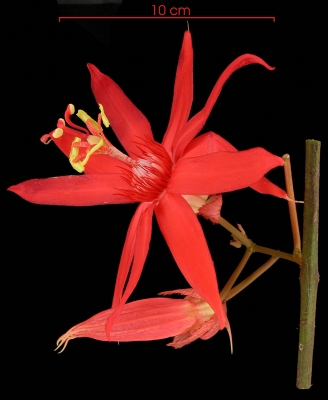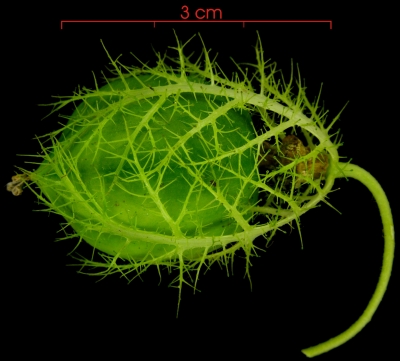*The Global Plants Initiative Meets at the Smithsonian in Panama Jan. 11-13*
For centuries, jungle explorers from Europe and North America have created art of the plants they discover—pressing bright flowers and green tendrils onto herbarium sheets for prestigious museums and plant collections. But scientists in the most biodiverse countries lack easy access to this basic information needed to identify plants. The Global Plants Initiative, meeting Jan. 11-13 at the Smithsonian Tropical Research Institute in Panama, catapults biodiversity research to a new level, sharing plant collections in a massive online database of high-resolution scans.

Herbarium specimen. Identify plants using your handheld computer or phone! Plant collectors dry plants and mount them on paper sheets that are stored in plant collections called herbaria. This plant specimen was collected in Panama nearly 100 years ago by Henri Pittier. The Global Plants Initiative puts high resolution scans of the specimens used by botanists to name plants on the internet. Representatives from 36 countries are meeting at the Smithsonian Tropical Research Institute from Jan. 11-13. Image credit: STRI
“In the past, when we wanted to confirm the identity of a plant collected in the field, we shipped samples to experts or travelled to herbaria—both extremely costly and impractical,” said Mireya Correa, staff scientist at STRI and professor of botany at the University of Panama. “New technological advances have put this information right at our fingertips on JSTOR—an online database of academic information.”
Turning a digital scanner upside down, a photographer at the Royal Botanic Gardens at Kew, U.K., revolutionized digitalization of centuries-old plant specimens glued to brittle paper by suspending the scanner above them. By offering free scanners and training to major herbaria, the Andrew W. Mellon Foundation sponsored a project to make collections of African plants readily accessible even to botanists in the world’s most remote regions.

Latin American Plants Initiative group photo. The Latin American Plants Initiative, representing GPI partners from Central and South America, met in late 2009 in Medellin, Colombia. The Global Plants Initiative currently partners with 175 museums, universities and herbaria from 60 countries and is actively working to further extend participation. Image credit: STRI
STRI is now a regional digitalization center for a Latin American Plants Initiative that coordinates scanning of specimens from herbaria that did not have collections large enough to qualify for their own scanner.
The Global Plants Initiative currently partners with 175 museums, universities and herbaria from 60 countries and is actively working to further extend participation. Its database holds almost 1.5 million images, among them 151,000 images of botanical artwork, photographs and reference materials. Nearly 7,500 new scanned objects arrive each week. Representatives from 36 countries will be present for the meeting at STRI.
“The Global Plants Initiative is a very big deal for anyone concerned with big questions that require going beyond analyses of individual sites,” said Helene Muller-Landau, an ecologist working with the 40 forest sites in 21 countries that form the Smithsonian’s Global Earth Observatory system. “One of the major problems with comparing data from different places is that the same species may be given one name in Brazil and another in Ecuador. Now, online plant specimens give all botanists access to the same references and should greatly increase the consistency and accuracy of species identifications.”
“This year we celebrate 100 years since Smithsonian scientists first surveyed the flora and fauna of Panama,” said Eldredge Bermingham, director of STRI. “Canopy cranes carry researchers into the treetops where the world’s insect biodiversity is found. Scientists who once studied animal behavior with binoculars now have satellite data on animal movement. The Global Plants Initiative, in conjunction with other new tools like genetic barcoding, will revolutionize plant biology—sharing information with countries where it was collected long ago.”
To see the amazing detail of these scans for yourself, enter https://plants.jstor.org/, search on a region, collector, plant or herbarium to generate a list of plants. Once you have a plant in front of you, go to the viewer tool to take a very close look at the details—star-shaped hairs, translucent dots, stamens loaded with pollen grains—that allow botanists to distinguish one plant from another and to give it a name. https://www.flickr.com/photos/jstor/sets/72157623811084023/
The Smithsonian Tropical Research Institute, headquartered in Panama City, Panama is a unit of the Smithsonian Institution. The institute furthers the understanding of tropical nature and its importance to human welfare, trains students to conduct research in the tropics and promotes conservation by increasing public awareness of beauty and importance of tropical ecosystems. www.stri.org and https://biogeodb.stri.si.edu/gpi/.
*Source: Smithsonian Tropical Research Institute


